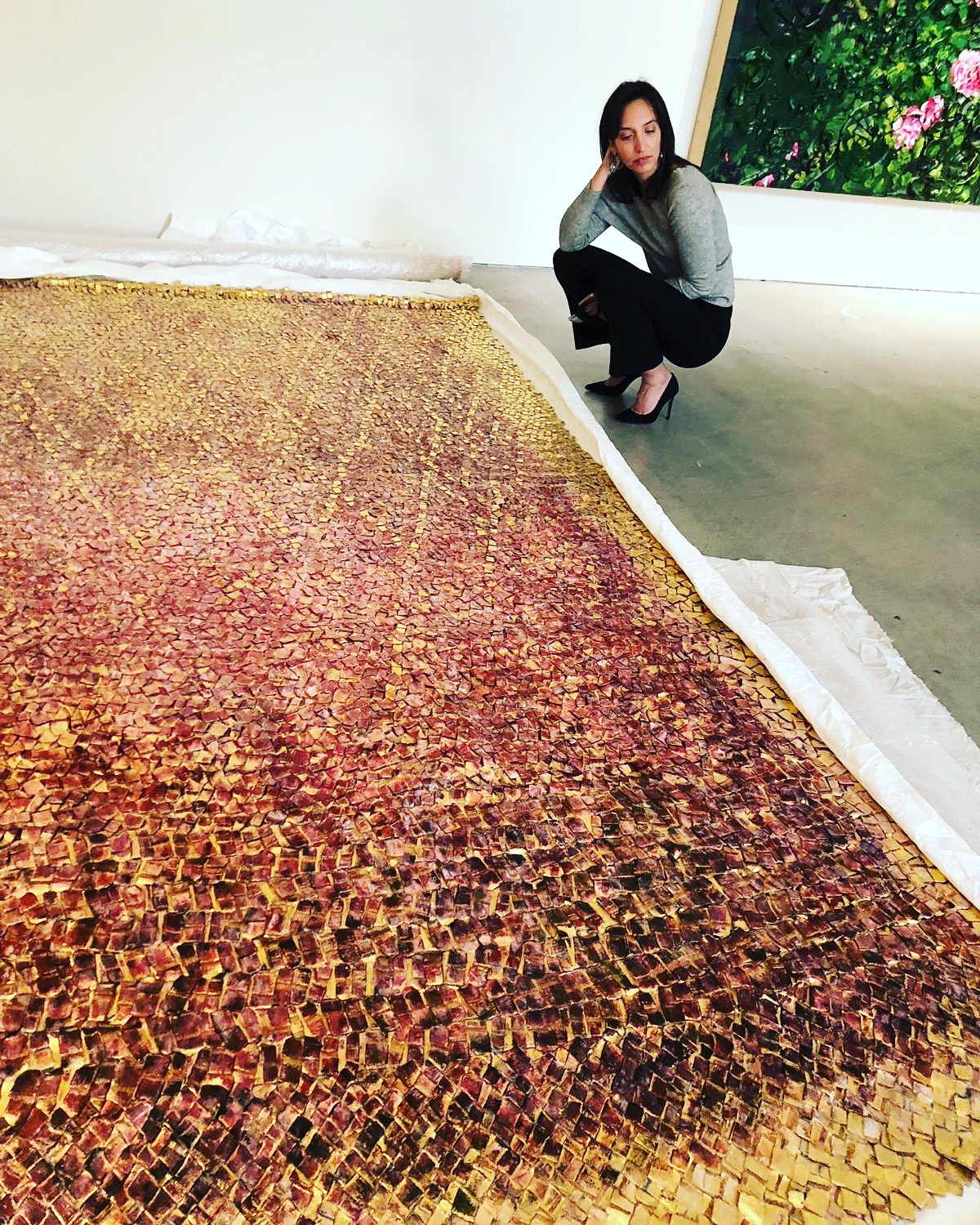5 Questions with Art Advisor and Appraiser Andrea M. Zorrilla, AAA
Nov 13, 2025
With more than a decade of experience at the highest levels of the fine-art world, Andrea M. Zorrilla, AAA has carved out a remarkable niche as an advisor, appraiser and scholar of Modern and Contemporary Latin American and Latinx diaspora art. Formerly Vice President and Specialist of Latin American Art at Sotheby’s in New York, she oversaw record-setting sales, curated landmark exhibitions and helped shape conversations around women’s contributions to Latin American art. Now based in Miami after years in New York, she is poised at the crossroads of art market dynamism, cultural identity and global collecting trends.
In this interview we’ll explore Andrea’s personal journey, the evolving Latin American and Latinx art market, why understanding cultural and historical context is critical, and her take on why appraisals are an important component to collection management.
1AN: You helped shape record-breaking sales for artists like Maria Martins, Olga de Amaral, Alice Rahon and Zilia Sánchez during your time at Sotheby’s. What did that experience teach you about how the market recognizes and sometimes overlooks value in Latin American and Latinx art?
Andrea Zorrilla: Directly handling the works that would ultimately achieve world auction records for each of these artists continues to be one of the greatest thrills of my career. Each of these women are seminal figures in the story of Modern and Post-War artistic production; their recognition by the market was long overdue. Most importantly, since those respective moments their markets are continuing to experience upward trajectories.
Art history is a global story shaped by vast networks of interconnected and pan-continental artistic exchange. With that said, Latin American artists, artists of the Caribbean diaspora and Latinx artists have often been omitted or briefly mentioned by name from modern Western art history and contemporary American art history.
Visibility of these artists on global market platforms are essential to legitimizing their markets and correlated pricing to the wider collecting public: international auction, art fairs, gallery representation in addition to normalizing their presence within settings such as institutional collections, exhibitions, and critical writings of the arts.
1AN: Agreed that such visibility is essential. So, after more than a decade at one of the world’s top auction houses, you launched AMZ Art Advisory & Appraisals. How does working independently change the way you advocate for artists and guide collectors in building more intentional, globally aware collections?
Andrea Zorrilla: The foundation of my professional ethos has not changed since forming my own independent fine art service. I continue to be driven by the belief that intentional and conscious collecting practices are essential to supporting the larger arts ecosystem. Clients come to me with the understanding that these principles are integral in driving my uniquely oriented advisory services.
In my capacity as independent advisor, I work with my clients in expanding the potential of their collections by introducing a fresh, alternative viewpoint that foregrounds the Global South and/or Latinx practitioners. Essentially, I remove categorical boundaries and ensure a historically coherent, globally attentive visual storyline.
Collecting art should be joyful. A collector, however, should also be willing to challenge themselves by collecting outside of categorical silos and to look beyond trends and “investment return”. The more a collector is challenging themselves, the more their interests and curiosity expand, they more they engage with globally panoramic viewpoints; eventually that discovery and evolutionary process is reflected in their collections/collecting decisions.
 1AN: Perhaps this is why we’ve been seeing growing institutional and market attention toward artists from Latin America and the Caribbean diaspora. From your perspective, what’s driving this renewed global interest and how does it differ from the earlier wave of “Latin American art” sales at auction?
1AN: Perhaps this is why we’ve been seeing growing institutional and market attention toward artists from Latin America and the Caribbean diaspora. From your perspective, what’s driving this renewed global interest and how does it differ from the earlier wave of “Latin American art” sales at auction?
Andrea Zorrilla: Across the last decade, a re-positioning of Latin American and Latinx artists to the international collecting public has been seismic in expanding market awareness.
First, a critical wave of new scholarship is taking on rigorous reassessments of art historical movements and is presenting alternative, untold stories that are inclusive of previously overlooked artistic practitioners.
Also, museum curators with global perspectives are reshaping institutional collections and mounting groundbreaking exhibitions. Meanwhile, museum patrons are demanding more diverse and globally tuned-in representation in both curatorial viewpoints/staff in addition to acquisitions.
And in a response to collector expectations and their evolving taste demands, the major auction houses have recalibrated their traditional, siloed categorical formula by integrating Latin American art and Latinx art into their global sales. In parallel to this, art fairs are diversifying the demographic of galleries and exhibited artists.
The above platforms have been essential in heightening the market presence of Latin American, Latinx, and Caribbean artists. Most importantly, the visibility of these artists must be ongoing and maintained.

1AN: You often emphasize “cross-category integration and contextualization” in collection planning. Can you explain what that means in practice and why understanding cultural and historical context is critical when building a meaningful collection?
Andrea Zorrilla: I typically work with a wide spectrum of clients, including private collectors, family offices, collection managers and art advisory teams, who have an interest in broadening the art historical impact of their existing and/or growing collections.
Given my decade-plus experience as a trained specialist in both Modern and Contemporary Latin American art and Latinx art, working with clients who collect across multiple categories is second nature to me. Identifying narrative “gaps” as a means to develop a strategic and practical roadmap that incorporates cross-category, multi-disciplinary and multi-generational artistic dialogues within a collection is the core of my advisory practice.
Examples of these narrative threads could be placing a Wifredo Lam next to a Kerry James Marshall with an Agustín Cardenas installed alongside them; an Alejandro Puente installed next to a Frank Stella and a Fanny Sanin; an Ana Mendieta displayed alongside a Joan Jonas and a Carolee Schneemann, a Sarah Grilo hanging right next to a Jean-Michel Basquiat. The narratives are endless as is the potential to continue extending these narrative threads with deliberate and careful foresight.
Building these panoramic collections require earnest commitment from the client as well as a willingness to practice slowing down and taking a mindful approach to buying in order to maintain the integrity of their collection.
1AN: You also function as an appraiser, providing appraisal related services via your independent practice. Can you discuss why appraisals are an important component to collection management?
Andrea Zorrilla: Being an appraiser is a profession, it takes significant time and hands on, in-the-weeds experience to develop the skill set needed to perform an appraisal that maintains compliance with the Uniform Standards of Professional Appraisal Practice, while also utilizing your knowledge base in a particular area of expertise to form a competent, sophisticated and relevant value narrative.
When it comes to collection management, appraisers are equally important stakeholders in supporting the responsible stewardship of a collection. To that end, an appraisal can provide valuable insight for a collector and inform their decision-making when it comes to proper care of their collection. An art collector is ultimately a temporary keeper of an artwork with the great responsibility of ensuring the safety and legacy of that work. An example is conducting insurance appraisal updates every few years to best determine appropriate coverage on relevant works. This may avoid the risk of being underinsured in the event of damage or loss to an artwork or alternatively having an artwork overvalued thus impacting premium payments. Another example is for the purpose of legacy and estate planning. An appraisal can be a factor used to determine equitable distribution, long-term/generational maintenance, deaccession options, among other wholistic planning considerations
Connect with Andrea here.
Author

Andrea M. Zorrilla
Andrea M. Zorrilla, AAA has over a decade of experience in the fine art industry, with expertise in modern & contemporary Latin American art in addition to the Latinx diasporas.
She is a Certified Member of the Appraisers Association of...
Recommended Videos
:sharpen(level=1):output(format=jpeg)/wp-content/uploads/2023/07/ASF23-promo-pics-3222.jpg)
Charlie Manzo, Alaina Simone, Muys Snijders, Kyle McGrath, Caren Petersen, Jason Rulnick, Elysian McNiff Koglmeier, Bianca Cutait, Linda Mariano, Jack Mur
:sharpen(level=1):output(format=png)/wp-content/uploads/2016/06/Steven-Schindler-1.png)
:sharpen(level=1):output(format=png)/wp-content/uploads/2016/06/Katherine-Wilson-Milne-1.png)
:sharpen(level=1):output(format=png)/wp-content/uploads/2016/10/Jacqueline-Towers-Perkins.png)
:sharpen(level=1):output(format=png)/wp-content/uploads/2018/10/Roxanne-Cohen.png)
:sharpen(level=1):output(format=png)/wp-content/uploads/2019/07/Alanna-Butera.png)
:sharpen(level=1):output(format=png)/wp-content/uploads/2016/01/Annelien-Bruins-1.png)
Steven R. Schindler, Katherine Wilson-Milne, Jacqueline Towers-Perkins, Roxanne Cohen, Alanna Butera, Annelien Bruins
:sharpen(level=1):output(format=png)/wp-content/uploads/2016/06/Steven-Schindler-1.png)
:sharpen(level=1):output(format=png)/wp-content/uploads/2016/06/Katherine-Wilson-Milne-1.png)
:sharpen(level=1):output(format=png)/wp-content/uploads/2016/10/Jacqueline-Towers-Perkins.png)
:sharpen(level=1):output(format=png)/wp-content/uploads/2016/01/Annelien-Bruins-1.png)
:sharpen(level=1):output(format=png)/wp-content/uploads/2018/05/Mary-Buschman-1.png)
:sharpen(level=1):output(format=jpeg)/wp-content/uploads/2015/12/Heidi-Lee-Komaromi1.jpg)
:sharpen(level=1):output(format=png)/wp-content/uploads/2017/04/Drew-Watson.png)
Steven R. Schindler, Katherine Wilson-Milne, Jacqueline Towers-Perkins, Annelien Bruins, Mary Buschman, Heidi Lee-Komaromi, Drew Watson

:sharpen(level=0):output(format=jpeg)/wp-content/uploads/2025/11/Olga-de-Amaral.jpg)
:sharpen(level=1):output(format=jpeg)/wp-content/uploads/2025/11/kian-lem-s_HqmrMsph8-unsplash-scaled-e1764007192632.jpg)
:sharpen(level=1):output(format=jpeg)/wp-content/uploads/2021/11/5-Things-You-Should-Do-When-Buying-Art.jpg)
:sharpen(level=1):output(format=webp)/wp-content/uploads/2025/11/sebastien-Laboureau-with-art-at-sagamore.jpg.webp)
:sharpen(level=1):output(format=jpeg)/wp-content/uploads/2025/11/Banner-Image.jpg)
:sharpen(level=1):output(format=jpeg)/wp-content/uploads/2025/11/Olga-de-Amaral.jpg)
:sharpen(level=1):output(format=jpeg)/wp-content/uploads/2025/11/F7642843-7A6C-4F72-964E-78BF1B6D4706_1_201_a-scaled.jpg)